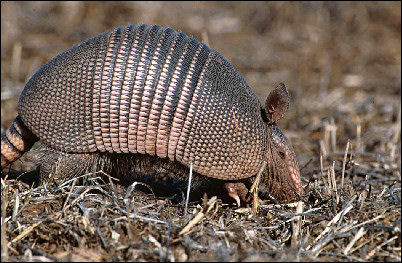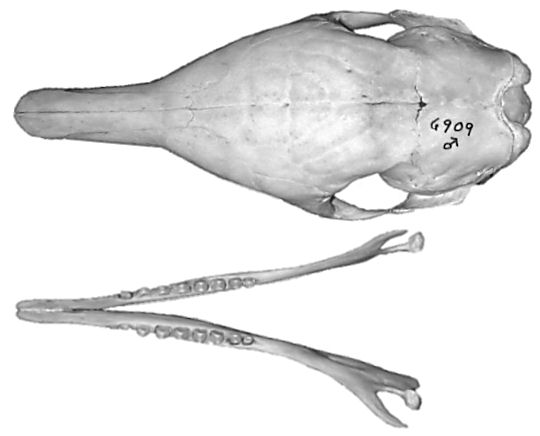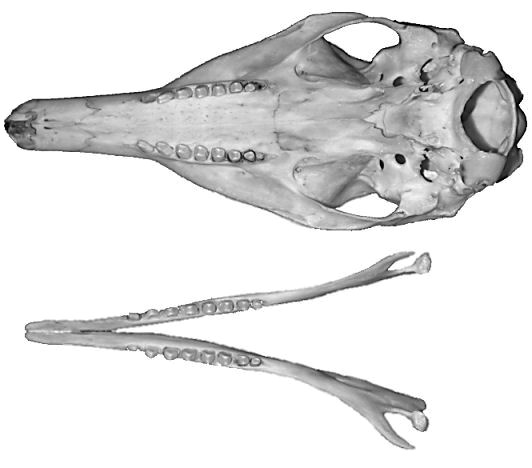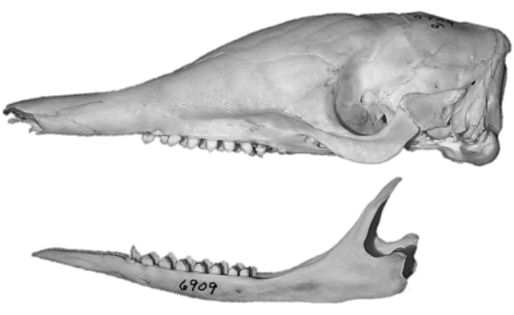The Xenarthra has been raised from the ordinal level to that of Magnorder (the former order Xenarthra also has been recognized at times under the name Edentata). What was the order Xenarthra currently is recognized as two orders, the Cingulata and the Pilosa. The name Edentata referred to the toothless condition found in some of the group; however, most do have teeth, though the teeth lack enamel and are single rooted. The name Xenarthra referred to the presence of an extra articulation between the lumbar vertebrae. These are zygapophysis-like and lie ventral to the zygapophyses; they are found in no other mammalian group. Other characteristics of the original group include an annular tympanic bone and a small brain that usually is encased in a long, cylindrical braincase. The ischium usually is expanded and specialized, often with a symphysis with some of the caudal vertebrae as well as with the sacral vertebrae. The magnorder is limited to the New World, with most of its evolution and taxa (living and fossil) in South America.
The cingulates are the armadillo and armadillo-like mammals. Only one family, the Dasypodidae, occurs in the U.S. A cingulum is a belt, and these taxa have armor, some of which often is arranged in bands about the body much like a belt would be—thus the name. The armor is of dermal bone and consists of articulated plates and overlapping plates joined by flexible connective tissue; the armor proper is overlain by dermal and epidermal tissue. The armor usually covers the top of the head, the top and sides of the body, and the tail. All living dasypodids (some 20 species in eight genera) in this group are members of the Dasypodidae, but there are a number of allied, extinct families. Among the latter is the Glyptodontidae, large armored forms with inflexible body armor; pieces of the thick armor are found in El Paso Plio-Pleistocene fossil deposits.
The living representative of the order in the U.S. is Dasypus novemcinctus, the Nine-banded Armadillo (fossil remains of other taxa are known from North America).
The Nine-banded Armadillo has expanded its range during historic times under natural conditions from Mexico and from introductions into Florida. A general pattern at the northern limits of its range is extension during relatively warm years (warm winters) followed by retreat (mortality) caused by cold winters. The western limit of its geographic range appears to be set by dryness, presumably through the restriction of the numbers of invertebrate prey animals (particularly insects). Its range doesn't reach west of the Pecos today (and mostly stops farther to the east).
The Nine-banded Armadillo has peg-like (homodont) teeth without enamel. The axis and cervicals 3 through 5 are fused together. The pelvis is massive, with a number of sacral and caudal vertebrae fused to the innominata; various projections extend out to brace the carapace, but there is not actual bone to bone contact. Feet are heavily clawed and plantigrade. The animal is an excellent burrower. There is delayed implantation (the zygote develops to the blastocyst stage but then remains floating in the reproductive system, unimplanted, for some period of time before implantation and subsequent embryonic development occurs) and monozygotic polyembryony (a single zygote divides to form a clone of four embryos in D. novemcinctus).

Fig. 1. Nine-banded Armadillo (Dasypus novemcinctus). Photo by John and Karen Hollingsworth, courtesy of the U.S. Fish and Wildlife Service.

Fig. 2. Dorsal view of the skull and mandibles of the Nine-banded Armadillo (Dasypus novemcinctus). Laboratory for Environmental Biology specimen.

Fig. 3. Ventral view of the skull and mandibles of the Nine-banded Armadillo (Dasypus novemcinctus). Laboratory for Environmental Biology specimen.

Fig. 4. Lateral view of the skull and mandibles of the Nine-banded Armadillo (Dasypus novemcinctus). Laboratory for Environmental Biology specimen.
The living two-toed and three-toed sloths are tropical forms. However, the large megalonychid ground sloths were common in North America, including the El Paso region, following the establishment of the Central American land bridge in the Pliocene, about 3,500,000 years ago. One of the best known finds of the Shasta Ground Sloth (Nothrotheriops shastensis) is from the Aden Crater area northwest of El Paso. That specimen, between 11,000 and 12,000 years old, preserved some soft tissues along with the skeleton and dung.
The family Myrmecophagidae consists of xenarthran anteaters, with a geographic range extending from southern Mexico south into South America. The Giant Anteater has been found as a fossil as far north as Sonora. In common with most anteaters, pilosan anteaters are toothless with extremely long tongues.
Last Update: 21 Jan 2008
Centennial Museum and Department of Biological Sciences, The University of Texas at El Paso